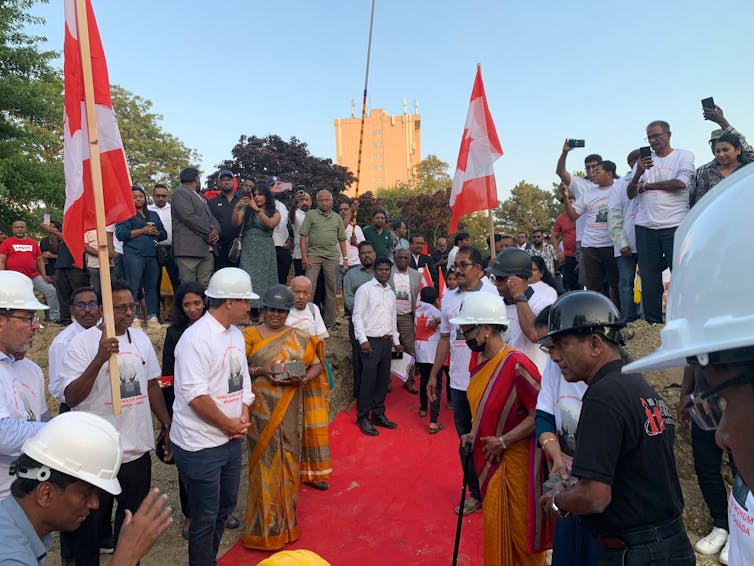Last August, a foundation stone laying ceremony was held in Brampton, Ont. for a Tamil genocide monument in the city. The memorial’s architectural design was selected from among 100,000 submissions and finalized by the National Council of Canadian Tamils in 2022.
It represents a significant victory for Sri Lankan Tamils, both in Canada and globally. Tamil separatists fought a three-decade long civil war against the Sri Lankan government and memorialization surrounding the war has remained a highly contentious issue.
The memorial also drew protests from those against its construction. Around a dozen people showed up to the ceremony to protest the memorial’s construction. Earlier, Sri Lanka’s Consul General in Toronto, Thushara Rodrigo, wrote a letter to Brampton mayor Patrick Brown opposing the memorial. Then Sri Lankan Minister of Foreign Affairs, Ali Sabry, raised concerns about the monument and its “damaging impact” on bilateral relations between Sri Lanka and Canada.
Following the ceremony, Brown said on X that he was proud to “mark the beginning of the construction of the Tamil Genocide Monument” and said the Sri Lankan government “continues to evade accountability at the International Criminal Court.”
Sri Lanka is a multi-ethnic country, with the Sinhalese majority making up over 70 per cent of the population, while the Tamil population are just over 10 per cent. The controversy surrounding this memorial highlights the broader memory wars around the history of Sri Lanka’s civil war: how it is remembered and by whom.

(X/Patrick Brown)
How Sri Lanka’s civil war is remembered
May 19 in Sri Lanka marks the anniversary of the end of the civil war. Events on that day tell two stories about the war between the Liberation Tigers of Tamil Eelam (LTTE) and the Sri Lankan government. One is that the government defeated ethnic separatism and terrorism, with state forces sacrificing their lives for peace. This is the officially designated story outlined in National War Heroes Day.
The second story is one of genocide. Mullivaikal Remembrance Day, also known as Tamil Genocide Memorial Day, observed on May 18, commemorates the events that unfolded in Mullivaikal, a village in northern Sri Lanka. According to the 2011 United Nations experts’ report, an estimated 300,000 civilians were trapped in a designated “no fire zone,” where they were subjected to indiscriminate shelling by government forces which is believed to have killed thousands.
The government’s narrative about the events at Mullivaikal is that the LTTE were holding civilians hostage, which resulted in a large-scale humanitarian rescue by the Sri Lankan army. However, the survivors of that period recount how lucky they were to survive, and continue to seek justice for their kin who did not.
Conflicting reports exist of the total number of casualties during the last phase of the war. The United Nations estimated that up to 40,000 civilians were killed in the final phase of the war. The Sri Lankan ministry of defence says 250,000 civilians were rescued.
However, allegations of genocide and mass killings persist, particularly among Tamil diaspora communities that continue to push for accountability.
Monuments and memory wars
In 2022, Canada’s parliament voted to recognize May 18 as Tamil Genocide Remembrance Day. In 2021, Ontario passed legislation recognizing a Tamil Genocide Education Week every May. However, groups in Canada, such as the Ontario Centre for Policy Research, have battled to scrap the bill.
In Sri Lanka, however, the main contention with “remembrance” is that states often hesitate to acknowledge their past actions, particularly in cases involving alleged serious violations of human rights. This is irrespective of the fact that such remembrance have been catalysts for reconciliation in other places where mass atrocities were committed, such as Rwanda. For example, the Kigali Genocide Monument in Rwanda has been a source for remembrance, learning and peace.

(AP Photo)
In 2019, a monument was built at the University of Jaffna in northern Sri Lanka to commemorate Tamils who died, but it was destroyed by Sri Lankan soldiers and police in January 2021, leading to protests and hunger strikes by students.
Under international pressure, the government allowed its reconstruction later that year, although Sarath Weerasekera, then public security minister, said “no one will and should be allowed to commemorate dead terrorists.”
The right to remember
Remembrance includes activities such as archiving, storytelling, building memorials, performing rituals and holding ceremonies such as the Tamil Genocide Remembrance Day in Canada.
Whether or not governments have an obligation to recognize remembrance as a right is a difficult question. Honouring the memory of victims of human rights abuses is recognized within the UN’s right to truth. In transitional justice, for countries emerging from violent conflict, remembrance is a way to come to terms with the loss of life during war.
The newly elected Sri Lankan government has rejected the latest UN Human Rights Council draft resolution calling for war crimes probes continuing Colombo’s policy on the genocide issue.
However, the government’s stance on remembrance could shift if re-framed around national reconciliation.
Every year, the current president’s party, Janatha Vimukthi Peramuna (JVP) which is part of the National People’s Power coalition, commemorates their members who died during the 1971 insurrection. The commemoration is known as April Heroes day. If the governing party holds commemorations for former insurgents, they may as well allow Tamil commemorative practices inside and outside of the country for national reconciliation purposes.
Moreover, Sri Lankan Prime Minister and former academic, Harini Amarasuriya, has written that both JVP insurrections and Tamil militants shared frustrations over socioeconomic and ethnic exclusions.
Therefore, the possibility remains for remembrance to be re-framed through reconciliation, minimizing frictions among Sri Lankans at home and in the diaspora. This is especially important for Canada, where the Sri Lankan diaspora numbers around 200,000 people.
